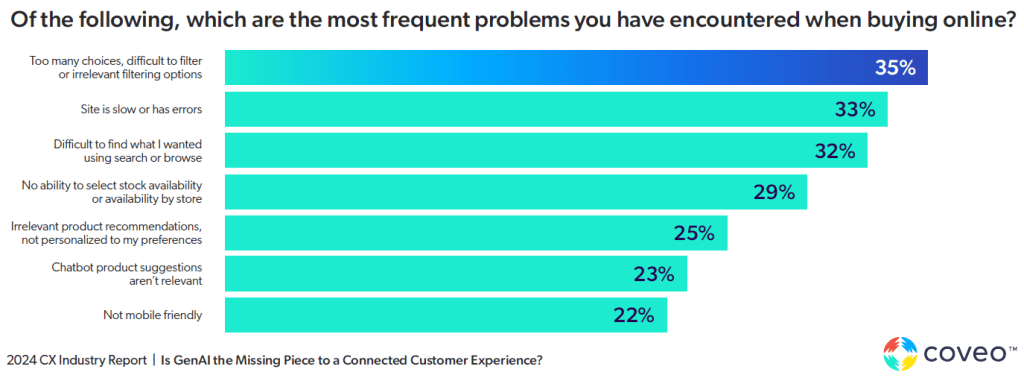For many companies, the digital experience (DX) and the customer experience (CX) have become one and the same. And for those companies that also provide brick-and-mortar experiences, making digital touchpoints seamless and consistent is still critical to customer satisfaction.
Coveo’s 2024 CX Industry Report highlights the significant role of AI and streamlined search functionality in unifying digital touchpoints. It also underscores that we are at a critical turning point in digital customer experience – customers are demanding something better, and many experiences are not yet meeting their high expectations.
Thankfully, the report offers guidance about how companies can meet and exceed evolving customer expectations.
Among the many interesting findings, several stand out as being both urgent and important:
Siloed Touchpoints Lead to Inconsistent Brand Reputation and CX
As companies get bigger, they invariably become more siloed. This is a mistake, as it often makes employees’ jobs more difficult and almost always affects the customer negatively.
As the report states: “When touchpoints are siloed there is no way to consistently uphold your brand’s reputation or, more importantly, provide a coherent, empathetic customer experience.”
Corporate silos are customer experience killers because customers don’t care about how your company is organized. Despite the efforts of so many brands to become customer-centric across the past decade, these silos have been seemingly indestructible. But they don’t need to be, at least when it comes to the consistency of information that you provide, as technological advances can help to unify your digital customer experience
So while it may seem sensible to explain to a customer that a different department is in charge of their issue, customers simply don’t care and nor should they have to. It is the responsibility of the company to make its own silos invisible to customers.

In a siloed company, it’s important that each employee takes the time to think about how customers experience their particular part of the journey. A good rule of thumb is to always consider where the customer was before they arrived at this point in the journey, and where they’re going next. This ensures a smooth transition, eliminating potentially confusing handoffs that can negatively affect the customer experience. If every employee took this one extra step, then silos wouldn’t matter.
It is also critical that everyone on the team has a clear map of the customer journey. Many companies skip the step of developing a journey map because it’s arduous and time-consuming. But putting yourself in your customers’ shoes and understanding every step of their journey is the surest way to identify and fix pain points along the way.
Relevant Reading: Overcome Silo Mentality With Effective Intranet Search
Search Has the Biggest Impact on Customer Perception
“Information findability – that is, search – has the biggest impact on customer perception of the brand,” the report notes. And the numbers back up this assertion: 42% of customers go straight to a company’s website or help center to find information, while another 37% go straight to Google. And since Google regurgitates information found elsewhere, you want that information to come from your digital properties.
“You want your company to be the primary source of truth for customers seeking information,” says Coveo’s Senior Product Marketing Manager Devin Poole.
Sixty-one percent of respondents said that finding both what they sought in a few clicks and supporting content would have the strongest impact on what they thought of the company.
But the biggest impact to brand perception is “not being able to easily search for and find the information I’m looking for on my own.”
Thus, although search is a critical component of the digital experience, it is also something that often misses customer expectations. This is especially true for younger consumers, who were more likely to cite problems with website navigation and search.

The most frequent problems people encounter, according to Coveo’s report, include too many choices, difficulty filtering results, not being able to find answers using search or browse, and a slow or error-filled site.
“Companies have long tried to provide customers with more choice and more options in an effort to please many diverse segments,” says Poole. “But what customers really want is contextual guidance on the potential solutions to their problems.”
Two actionable solutions for improving search results on a website or mobile app include:
- Tracking customer search history and taking action to make search easier. If somebody is searching for something on your website, it probably means they can’t find it! And just like you’re probably tracking Google search results, so too should you be tracking results on your own site’s search bar.
So if the same search term appears in the monthly onsite search report, perhaps it’s time to make that item more visible. This can include making it more prominent in top, side, or bottom navigation, integrating it into the content of the page, or offering it as a suggested search as users start typing.
- Integrating usability testing into the digital experience development workflow. Usability testing involves finding actual customers to test website functionality in a realistic setting, and then studying their actions. It is remarkable how often a programmer will think something is easily findable but an actual customer will have difficulties; usability testing can highlight these discrepancies and usually identify a clearer solution.
Testing should be left to professionals, but in a pinch you can ask a customer to perform a task while verbally explaining their thought process and sharing their screen.
AI Can Help Streamline and Personalize DX
In almost every industry, artificial intelligence is changing the game for customer experience. Companies are taking advantage of AI’s capacity to collect huge quantities of consumer data, analyze and anticipate customer needs, and make personalized recommendations that can drive engagement.

AI algorithms can also use predictive analysis to understand and anticipate consumer behavior, helping businesses discern individual preferences and personalize experiences accordingly.
According to the Coveo report, there are many ways in which AI can be used to streamline and personalize the digital experience, including:
- Enhanced Information Findability: AI-driven search tools can significantly improve information findability and offer personalized search results that match user intent and context. It can also help ensure that the same query gets the same answer across different touchpoints, creating a consistent experience for customers and building trust.
- Personalization: AI can adapt content, recommendations, and advice in real-time based on user behavior and preferences. This ensures a more engaging and personalized experience for each visitor.
- Tailored Recommendations: AI can analyze vast amounts of data to offer tailored product recommendations. This helps in making the shopping experience more relevant, addressing the issue of irrelevant filtering options and product suggestions cited by a healthy percentage of respondents.
- Proactive Assistance: AI-powered virtual assistants can provide proactive assistance by guiding customers through their buying journey, helping with product selection and troubleshooting issues. As 72% of respondents said they expect digital experiences to evolve with trends like generative AI, this is an actionable way to differentiate and exceed expectations.
- Streamlined Self-Service: Early-generation chatbots could only handle simple (Tier 1) customer service requests using a rules-based approach. Today, “GenAI can uplevel self-service to take on Tier 2 issues, where pieces of an answer might exist across numerous documents,” says the report. This can speed up resolution time and free up humans to handle the most complex issues.
Complex or Unique Situations Continue to Need Human Support
Unfortunately, too many companies are still strategically making it difficult for customers to talk to a human. One of the main complaints customers cited in the report was “having to complete complex case submission forms to talk to an actual person.”
Whether it’s long submission forms, hiding the Customer Service phone number, long hold times, or complicated IVR (Interactive Voice Response) systems, intentionally standing in the way of a customer and a human agent rarely results in a positive experience.
The good news for consumers (and perhaps bad news for these companies) is that most industries have become highly competitive. Thus, it’s easy for a customer to defect to a competitor that might offer an easier experience. This makes solving the human engagement puzzle even more important.
The prudent approach is to look at AI not as a replacement for humans, but rather as a complement to them.
AI can help ease the burden on customer service agents by handling Tier 1 and Tier 2 issues while also empowering them with critical information and recommendations for more complex cases. This creates a better employee experience and a better customer experience.
This is also what customers want. According to the report, 35% of consumers said they prefer human service interactions regardless of the complexity of the case. Another 31% said they prefer self-service for easy issues like password resets, and a live agent for more complex issues.

Over time, expect AI and human interactions to converge.
“Companies have always looked to make their digital experiences ‘more human,’” says Coveo’s Poole. “AI will help to do that as it will learn during the experience, much like a human agent will adjust the conversation based on information shared by the customer.”
Conclusion
Probably the scariest data point in the entire 2024 CX Industry Report is that nearly 60% of consumers say they rarely or never complain. Companies should want to hear customer complaints (and definitely not be afraid of them). And, as the report states, “Not only does this put customers at risk of churn [what’s referred to as a ‘leaky bucket’], you can’t fix the issues you don’t know about.”
This underscores the urgency for companies to proactively address and improve their digital customer experience. By unifying digital touchpoints, investing in advanced search capabilities, leveraging AI for both simplification and personalization, and continuing to rely on human interactions when necessary, businesses can meet and exceed evolving customer expectations.
Get your free copy of the full report here:


